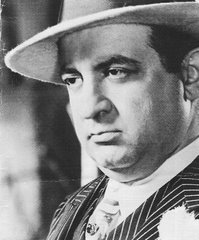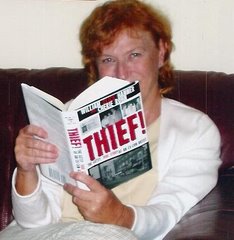
 Here it is the tail-end of 2009, a time for nostalgia. So, yours truly would like to share a particular part of her past when the casino world came crashing into her life.
Here it is the tail-end of 2009, a time for nostalgia. So, yours truly would like to share a particular part of her past when the casino world came crashing into her life.The Set-up: It's 1996 in Albuturkey, NM. (Actually, quite a neat town, Albuquerque.) I'd just been laid off along with all my co-workers from an independent TV station that was sold to the local Fox affiliate. Decent paying jobs were hard to come by. But I'd heard that blackjack dealers were making great tips at the Indian casinos that were popping up around the area. A little research convinced me that it would be worth my while to become a BJ dealer. Never a gambler, I was convinced things were much more profitable on the other side of the table.
ACES Casino Dealer's School: Enter ACES Casino Dealer's School run by one Larry Smith who would become a lifelong friend. (Well, so far anyway.) A kind of sleazy, goodlooking guy named Dean signed me up and took my cash. Whatever I paid, it was worth the price.
I was the opposite of those lucky few who seemed to be born with a deck of cards in their hand. In fact, I was so bad, I think they put me in the remedial school of BJ dealing. I'd done a lot of things for a living like singing in nightclubs, making maps and rowing customers down the San Juan River in Utah. As far as card games were concerned, I was totally out of my element and intimidated as hell.
For instance, one time Larry was showing a visiting casino exec around the place and I was dealing to my fellow students, mostly gorgeous things half my age or Oriental hotshots. I trembled so much everyone started to snicker. It was then that the visiting VIP, who looked like a young Al Pacino, squeezed up next to me and whispered, "Relax, honey. Just pretend you're having sex." At which point all the cards flew up in the air and rained down on our heads. It was the first of several emarrassing moments I was destined to endure!
Meeting Slick, One of my Teachers: It was at the school I met William Slick Hanner, a real character, who carried around 20 dog-eared pages of his life story, hoping to find some sucker to write it. Well, I took one look at what he'd written and it was like a bomb hit me. I just knew I had to write his story, even though the only thing I'd written were some lurid love letters. Nine agonizing years later, Thief was published by Barricade Books. But that's another story.
Blackjack Auditions: Now that I had practiced maybe hundreds of hours longer than any living soul, it was time to audition at REAL casinos! I'd rather have autitioned for Stephen Spielberg than those suave, confident pit bosses.
After some terrible auditions in the local market, I decided to take my audition uniform (black slacks, white tux shirt and bow tie) up to a little Northern New Mexico casino about 3 hours drive from where I lived. Desperate for any live bodies to pitch BJ cards, the Ohkay Casino in Espanola, NM, hired me. Yahoo!!! My first BJ gig. I stumbled along managing to keep my job for 3 months. But I was in dangerous territory as a gringa where most of the town was either Pueblo Indian or Hispanic. After my rented house was robbed twice by druggies, I decided I'd better high tail it back to Albuquerque.
Fake Nails, a Dealer's Bane: One of the casinos south of Albuquerque needed dealers. So I went down with the express purpose of only filling out an application as I wasn't in my audition uniform and hadn't dealt a card for over a month. For a break-in dealer like me with little experience, that was an eternity.
Well...the pit boss was very eager to hire a BJ dealer, and here I was with some actual experience. He said, "Hey. Let's throw you on a table right now and see what you can do." I nearly fainted, as I had donned fake red fingernails, the same ones I'd worn as a live TV personality, hoping to camouflage my chipped ugly things. Like a cornered animal, I could see there was no escape.
Forcing a smile, I tapped out the smug BJ dealer. He handed me the cards in the 2-deck game and clapped his hands to show surveillance he was clean. This part was mostly a blur until it came to my pitching cards to the 5 patrons ready to watch the newbee do her stuff. The first cards made it to their proper places in front of the customers and I breathed a sigh of relief. The only problem was the damn fake nails bent backward every time I shuffled. I could only imagine what the eye-in-the-sky was thinking. On the next hand, I pitched a card to a customer. Immediately he reached up and pulled a red thing from his forehead, squinted at it and said, "What's this?" One of my fake fingernails had flown off and hit the guy between the eyes, sticking there. Before I could answer, I was yanked off the table and a young dealer choking with laughter took my place.
What are You Doing with that Roulette Wheel?: "All right," the pit boss groaned, eying me like I was something from another planet. "Since you said you can deal roulette, let's see if you can do better on the wheel." I could tell he wasn't any too pleased and I'd better get it right this time or else.
To be continued.








 while living at mob headquarters in Chicago. There was Wheels now one of the floormen and Harry Tinderella, another mob guy. There was a former Chicago cop dealing blackjack. I spotted my old friend, former card mechanic Phil Diaguardi, now a shift boss. And Bobby Stella, the casino manager, used to run the Owl Club in Hammond, Indiana for the mob.
while living at mob headquarters in Chicago. There was Wheels now one of the floormen and Harry Tinderella, another mob guy. There was a former Chicago cop dealing blackjack. I spotted my old friend, former card mechanic Phil Diaguardi, now a shift boss. And Bobby Stella, the casino manager, used to run the Owl Club in Hammond, Indiana for the mob.




 Starting today I'm posting Slick's new take on Las Vegas: Slick Hanner's Las Vegas--Then & Now, a chapter at a time. We would like to hear your feedback.
Starting today I'm posting Slick's new take on Las Vegas: Slick Hanner's Las Vegas--Then & Now, a chapter at a time. We would like to hear your feedback.
